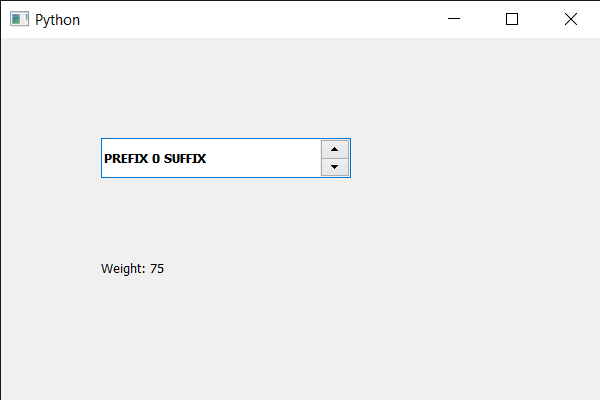En este artículo veremos cómo podemos obtener el peso del texto del cuadro de número. Font-weight está destinado a establecer el peso (negrita) de la fuente. Cuanto mayor sea el valor del peso, más texto estará en negrita. Podemos cambiar el peso de la fuente con la ayuda del setWeightmétodo.
Para hacer esto, usamos weightel método con el objeto QFont del cuadro de número.
Sintaxis: fuente.peso()
Argumento: no requiere argumento
Retorno: Devuelve entero
A continuación se muestra la implementación.
# importing libraries
from PyQt5.QtWidgets import *
from PyQt5 import QtCore, QtGui
from PyQt5.QtGui import *
from PyQt5.QtCore import *
import sys
class Window(QMainWindow):
def __init__(self):
super().__init__()
# setting title
self.setWindowTitle("Python ")
# setting geometry
self.setGeometry(100, 100, 600, 400)
# calling method
self.UiComponents()
# showing all the widgets
self.show()
# method for widgets
def UiComponents(self):
# creating spin box
self.spin = QSpinBox(self)
# setting geometry to spin box
self.spin.setGeometry(100, 100, 250, 40)
# setting range to the spin box
self.spin.setRange(0, 999999)
# setting prefix to spin
self.spin.setPrefix("PREFIX ")
# setting suffix to spin
self.spin.setSuffix(" SUFFIX")
# getting font of the spin box
font = self.spin.font()
# setting weight to the font
font.setWeight(75)
# reassigning this font to the spin box
self.spin.setFont(font)
# creating a label
label = QLabel(self)
# setting geometry to the label
label.setGeometry(100, 200, 300, 60)
# getting weight of the font
check = font.weight()
# setting text to the label
label.setText("Weight: " + str(check))
# create pyqt5 app
App = QApplication(sys.argv)
# create the instance of our Window
window = Window()
# start the app
sys.exit(App.exec())
Producción :
Publicación traducida automáticamente
Artículo escrito por rakshitarora y traducido por Barcelona Geeks. The original can be accessed here. Licence: CCBY-SA